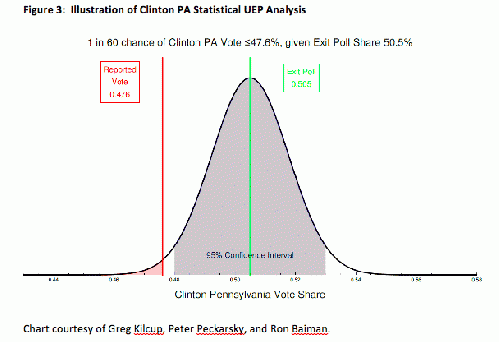c) Trump Presidential Exit Poll Discrepancies
As with Figure 2, Figure 4 below shows the results of this analysis for Trump UEP minus VC shares. Column D shows VC minus UEP percentage for Trump so that a negative percentage indicates that Trump's vote count was greater than his UEP share. Column G is the sample standard deviation (SD) estimated to be 30% larger than the standard random sample standard deviation after the cluster sampling adjustment. Column H gives the "Z-Score," or number of SD's, of the UEP -- VC deviation. Column I gives one-tailed P-Values (on either side of the distribution) for each state assuming a standard normal population with a mean equal to the UEP for Clinton and SD estimated in Column G. Under these standard sampling assumptions, these are the likelihood of the VC being this different from the UEP assuming random sampling error. P-values less than 5% are considered statistically significant as they indicate a 5% or less random chance that the VC share would be this different from the UEP share. Column J presents the same information (one divided by P-Value) in terms of the odds of VC share occurring given the UEP share. Columns K and L give the lower and upper bounds of the 95% confidence interval, or the range of VC values that have a 95% probability of occurring, given the Clinton UEP result. Since this is a two-tailed confidence internal, only VCs with P-values of 2.5% or less will be outside of this confidence interval.
As can be seen in Figure 4, statistically significant VC discrepancies with Trump UEP shares (with p-value less than 5%) occurred in OH, UT, NC, MO, NJ, IA, WI, ME, FL, GA, IN, PA, SC, NV, AZ, and CO (again recall per discussion above that UEPs for FL and MI are likely to be at partially adjusted and thus not true UEPs). In all of these states Trump's VC was greater than his UEP by a statistically significant margin. Note that though there were UEP -- VC deviations against Trump in MN and NY these were not statistically significant.
The most highly significant VC shifts for Trump were concentrated in suspect states suggesting that these "errors" were not random but a result of how the VC was counted. Moreover, unlike the overall VC shift against Clinton, the odds for such a one-sided VC shift for Trump in multiple states occurring as result of random sampling, or statistical, error, is a nearly impossible 1 in 710,147, as shown in Figure 4 cell 5P using a calculation similar to that used for cell 5L in Figure 1.
Furthermore, Figures 2 and 4 show that UEP discrepancies for the states with the largest "red shifts" in Figure 1: UT, MO, NJ, OH, ME, and NC, exhibit statistically significant UEP -- EP discrepancies both against Clinton and for Trump, an occurrence that is even more unlikely from random error than either significant discrepancy occurring without the other.
Figure 4: 2016 Presidential Election Trump Exit Poll minus Vote Count Margin
Figure 5 below illustrates the Trump UEP WI analysis conveyed in Figure 4, line 11. The normal distribution bell curve is centered around Trump's 44.3% WI UEP share and has a 1.2% SD (or approximate "width") as calculated in Figure 4. Based on this SD the 95% Confidence Interval (CI) displayed in the graph ranges from 42.0% to 46.6% as shown in Figure 4. This implies that there was a 95% chance that Trump's WI VC would fall within this range due to statistical sampling error. The blue area over the CI under the bell curve distribution contains 95% of the total area under the bell curve. As shown in Figure 5 Trump's reported WI VC of 47.9% is above the upper end of the CI, showing a statistically significant VC discrepancy with his UEP that would be expected to occur by chance only 0.1168% of the time, or less than a 1 in 856 chance.
Figure 5: Illustration of Trump WI Statistical UEP Analysis
Next Page 1 | 2 | 3 | 4 | 5 | 6 | 7 | 8 | 9 | 10 | 11 | 12
(Note: You can view every article as one long page if you sign up as an Advocate Member, or higher).







